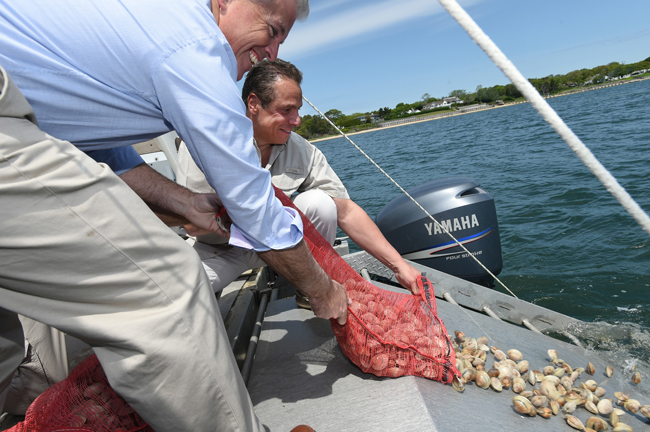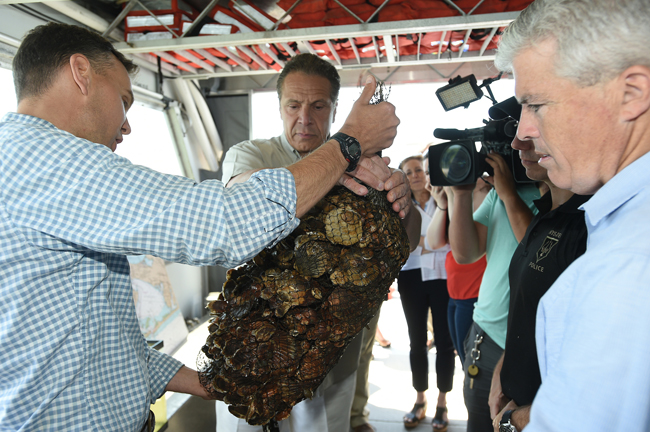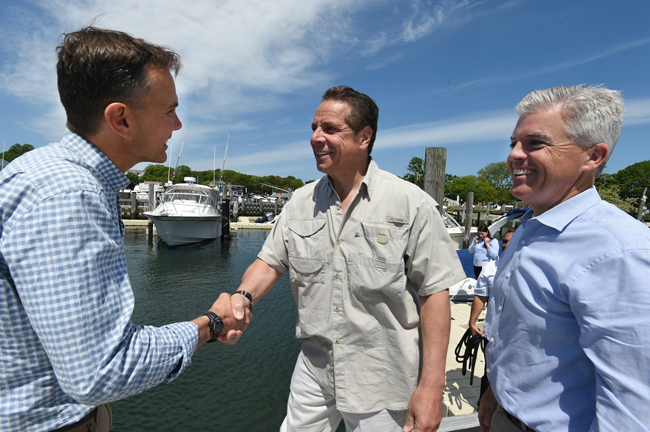Governor Cuomo Announces More Than $2 Million to Improve Water Quality and Prevent Brown Tide Blooms on Long Island
- As Threat of Federal De-funding Looms, State Invests in NY Sea Grant Program to Advance Cutting Edge Research
- Investment Will Restore Shellfish Populations to Improve Water Quality and Mitigate Brown Tide
- Supported by Record Investment in the Environmental Protection Fund
- Complements Historic $2.5 Billion Clean Water Infrastructure Act

Governor Andrew M. Cuomo, joined by Suffolk County Executive Steve Bellone and NYS Department of Environmental Conservation Commissioner Basil Seggos, toured the Shinnecock Bay in Southampton, Jun 2, 2017. Photo Credit: Office of the Governor / Kevin P. Coughlin/Office of Governor Andrew M. Cuomo
Contact:
Governor Andrew W. Cuomo's Press Office
E: Press.Office@exec.ny.gov, P: 518.474.8418 (Albany); 212.681.4640 (New York City)
Albany, NY, June 2, 2017 - Governor Andrew M. Cuomo today announced $2.05 million in funding to support the New York Sea Grant program, which advances an array of cutting edge research to improve the health of our oceans. The federal budget proposes to defund Sea Grant programs nationwide, decimating vital research on ocean health and water quality at a time when it is needed most. The state funding will allow NY Sea Grant to expand their critical work across Long Island. The investment will fund a variety of projects to address brown tide and harmful algal blooms, including the cultivation of clam and oyster populations, which filter and improve water quality.
"Long Island's unparalleled natural beauty, from the stunning coastline to the spectacular waters, is a key driver of the regional economy, and we must do everything in our power to protect the water quality and natural resources of our communities," Governor Cuomo said. "While the federal government threatens to defund vital ocean research at a time when we need it most, New York is stepping up and investing resources to keep this cutting-edge research moving forward, improve water quality, support the local economy, and protect the health of current and future generations."
"...we must do everything in our power to protect the water quality and natural resources of our communities," said Governor Andrew Cuomo at the press conference.
This new funding initiative involving New York Sea Grant and Stony Brook University is mentioned in both the video above as well as the audio below around 12 minutes and 35 seconds into this over 16-and-a-half minute video. Sea Grant is cited as the funding recipient around 13 minutes and 6 seconds in.
AUDIO:
Note: If you don't see the player above, it's because you're using a non-Flash device (eg, iPhone or iPad).
Sea Grant
The NY Sea Grant program is funded by federal and state funds and is a cooperative program of SUNY and Cornell University. New York State provides $400,000 per year to the NY Sea Grant, which advances an array of cutting edge research to improve the health of our oceans. NY Sea Grant has funded numerous research, extension and education efforts related to coastal issues in fisheries, coastal marine habitats, storm surges and flooding, seafood safety, wetland habitats, fisheries, and harmful algal blooms, among others. Some of NY Sea Grant's many important projects include:
- Administering the $1.28 million from EPA's Long Island Sound Study for examining the effects of nitrogen, red tide and climate change on the Long Island Sound ecosystem
- Research to better understand how east coast storms and hurricanes will change in future decades due to climate change and sea level rise, including combining storm surge models to make more reliable forecasts
- Initiation of New York’s first Seafood Summit in 2016, which examined strategic methods to improve the quality and safety of seafood and promote the industry
- Conducting the Great South Bay Marine Camp in partnership with the Town of Babylon in 2016, offering a summer “mini-camp” focusing on marine science education for youths in Western Suffolk County at the Bob Sweeney Sport Fishing Education Center
- Microsatellite analysis to evaluate stocks of summer flounder (fluke)
- Studies regarding fish consumption to better understand potential exposure to hazardous substances such as mercury and bacterial toxins like Listeria
- Studies of how paralytic fish toxin in algal blooms impact the productivity of hard and soft shell clams
- The NY Sea Grant Harmful Algal Bloom Action Plan, which Suffolk County is slated to release in the coming weeks, aims to improve filtration capacity by adding clams and oysters to Shinnecock Bay and elsewhere off Long Island.
Despite the myriad accomplishments of the program, the federal government is slated to defund the Sea Grant program, which would decimate the Sea Grant Program when it is most needed. New York will step up to support this vital research with $2.05 million from the Environmental Protection Fund in addition to the annual $400,000 investment. DEC will execute an MOU with NY Sea Grant in June.

Stony Brook University School of Marine and Atmospheric Sciences investigator Chris Gobler (at far left) is studying the impact that seeding clams and oysters as well as seaweed aquaculture has on reducing levels of nitrogen in Long Island’s bays, which could lessen the occurrence of brown tide blooms. He is discussing these concepts with (l-r) Governor Andrew M. Cuomo and Suffolk County Executive Steve Bellone. Photo: Office of the Governor / Kevin P. Coughlin/Office of Governor Andrew M. Cuomo
Brown Tide
Brown tide refers to several phytoplankton species that color the water brown at high concentrations and is primarily found in the eastern embayments of Long Island, including the Great South Bay, Moriches Bay, Shinnecock Bay, and the Peconic Bays system. Brown tide thrives in warm, shallow, nitrogen-polluted waters—fed by runoff from septic systems and cesspools.
Although brown tide is non-toxic, it can wreak havoc on the ecosystem—negatively impacting shell-fisheries and fin-fisheries. Brown tide can significantly decrease the amount of sunlight that penetrates through the water, thereby reducing the ability of other plants and algae to produce the energy they need to survive. This shading effect kills important habitats like eelgrass beds and can also inhibit the ability of shellfish to eat, grow and reproduce. Additionally, brown tide can deplete oxygen levels in the water causing much marine life to move out of the impacted area. In addition, the coffee-like appearance of the brown tide can dissuade swimming, recreational boating and tourism.
One of the most effective ways to address brown tide is to prevent nitrogen pollution and improve water quality to prevent the blooms from feeding. Current research is exploring the use of “bivalve restoration” (seeding clams and oysters) and seaweed aquaculture to improve water quality by removing nitrogen and preventing brown tide. Adult clams have demonstrated the ability to filter brown filter brown tide algae at low concentrations. To combat the devastating effects of brown tide on Long Island, this funding will support ongoing research and restoration of shellfish populations.
What's Fueling Harmful Algal Blooms in Long Island's Waters?
To get a better picture of the causes of harmful algal blooms in our local waterways, Dr. Chris Gobler offers a comprehensive explanation of
some of the prime contributors to harmful algal blooms, at least in the
bays of Long Island, NY. He is seen above in an extended 2013 interview
with News 12, a local television station with bases on Long Island, Connecticut and New Jersey. In this eight-and-a-half-minute Q&A, Gobler discusses, among other things, how groundwater contaminants affect local waterways.
As heard below, WSHU FM, NPR's local affiliate station on Long Island and Connecticut, released a brief audio segment (about a minute-and-a-half in length) in July 2016 that also helps to clarify the causes and severity of different harmful algal blooms.
AUDIO: "Explaining Those Harmful, Even Deadly, Algal Blooms" (WSHU FM, July 1, 2016)
Note: If you don't see the player above, it's because you're using a non-Flash device (eg, iPhone or iPad).

Stony Brook University professor Chris Gobler (at far left) greets (l-r) Governor Andrew M. Cuomo and Suffolk County Executive Steve Bellone. Photo: Office of the Governor / Kevin P. Coughlin/Office of Governor Andrew M. Cuomo
Improving Water Quality on Long Island and Across New York
This funding complements Governor Cuomo's ongoing, historic investments to reduce nitrogen pollution, mitigate future brown tides and improve water quality and infrastructure on Long Island and across the state.
Improving Water Quality on Long Island and Across New York
This funding complements Governor Cuomo's ongoing, historic investments to reduce nitrogen pollution, mitigate future brown tides and improve water quality and infrastructure on Long Island and across the state.
$2.5 Billion for Clean Water Infrastructure
The Clean Water Infrastructure Act is a $2.5 billion investment in drinking water infrastructure, clean water infrastructure and water quality protection across New York. This includes over $1.5 billion in grants for water infrastructure improvements and creates a $75 million rebate program to give homeowners and small businesses an incentive to replace and upgrade aging septic systems.
$388 Million Suffolk Sewering Initiative
The FY 2018 Budget investment builds on the $388 million initiative launched in 2014 to connect 10,000 homes from septic systems to sanitary sewer systems in the Carlls River, Connetquot River and Patchogue River, and Forge River watershed areas and southwest Suffolk County’s Sewer District #3.
$40 Million to Build Local Sewer Systems in Smithtown and Kings Park
The FY 2018 State Budget invests $40 million to build two local water treatment systems that provide vital support to the continued growth of the region. First, the $20 million Smithtown Business District Sewer Improvement Area project will install sanitary infrastructure in the business district. Additionally, a $20 million Kings Park Wastewater Treatment Facility be installed in the 100-acre, 140 lot central business district area adjacent to a railroad station.
Bay Park Treatment Plant
Treated sewage from the Bay Park treatment plant has been impacting Nassau County's Western Bays for decades. New York State is now working with Nassau County to evaluate the feasibility of diverting treated wastewater from the Bay Park treatment plant to the Cedar Creek treatment plant and its ocean outfall. By utilizing an existing, unused aqueduct, this innovative solution would be significantly faster and more cost-effective than the initial proposal to construct a new outfall pipe at Bay Park.
$5 Million Nitrogen Action Plan
The Long Island Nitrogen Action Plan is a multiyear initiative to reduce nitrogen in Long Island's surface and ground waters by DEC, the Long Island Regional Planning Council, and Suffolk and Nassau counties, with input from multiple partners and stakeholders.
Protecting the Long Island Sound Against EPA Dumping
In August 2016, Governor Cuomo announced New York's intention to fight the EPA's designation of the Eastern Long Island Sound Disposal Site. The EPA finalized the designation in December 2016 and, immediately thereafter, New York State issued a Notice of Intent to Sue under the Ocean Dumping Act. This lawsuit will be foremost in a series of actions taken by New York State over many years to oppose the harmful disposal of dredged material in Long Island Sound.
Department of Environmental Conservation Commissioner Basil Seggos said, “Governor Cuomo is making significant and historic investments to update New York’s wastewater infrastructure and protect the state’s waters through the $2.5 billion Clean Water Infrastructure Act. New York is investing in sound science to address environmental threats like brown tide by getting at the factors that contribute to algae and threaten the health of our waters and ecosystems.”
Suffolk County Executive Steve Bellone said, "Governor Cuomo recognizes the importance of Long Island’s unique natural treasures and the challenges we face to preserve and protect them for future generations. From investing in our water infrastructure to improving our parks and beaches, the Governor is providing instrumental support to help us strengthen and protect our natural resources. And today, he is again taking action for our communities and stepping up to ensure water quality on Long Island. We are grateful for his leadership, and for his continued support for Suffolk County."
Senator Thomas F. O'Mara, Chair of the Senate Committee on Environmental Conservation, said, “Water is one of this state’s most precious resources and it is our obligation to protect it and preserve it for future generations of Long Islanders. Brown tide is a scourge that threatens the Long Island coast, and with Governor Cuomo’s unprecedented investment in improving water quality on Long Island we have the opportunity to make a real difference in protecting our water resources when our counterparts in Washington turn their backs.”
Assemblyman Steve Englebright, Chair of the Assembly Committee on Environmental Conservation, said, “Under the leadership of Governor Cuomo, New York has taken significant action to reduce the amount of nitrogen leaking into the water. Thanks to these efforts and the efforts of communities all along the water, we are making tremendous progress reducing pollutants in the water. But there is more work to be done, and Governor Cuomo is providing the support we need to get it done, from investing in our water infrastructure to taking action to combat brown tide. I want to thank him and our partners across academia and government who are ensuring a better future for Long Island.”
Assemblyman Fred W. Thiele, Jr. said, “The Governor understands that protecting nature is not just right in itself; it is also critical to keeping our economy moving forward. On Long Island, many of our communities rely on the economic benefits of our unparalleled natural resources, from fishing and clamming to tourism and recreation. Since day one, Governor Cuomo has been a champion for the environment here on Long Island and across New York. With today’s actions to stem the brown tide, we are continuing to make progress to clean up our water waters and protect our natural treasures.”
Kathryn J. Boor, the Ronald P. Lynch Dean of the College of Agriculture and Life Sciences at Cornell University, said, "As New York's State Land Grant Institution, we've been pleased to partner with SUNY Stony Brook in the New York Sea Grant program. The Governor's leadership in ensuring New York Sea Grant can continue its critical programming in coastal resiliency and combating the effects of climate change is a welcome investment in our state's environmental future."
More Info: New York Sea Grant
New York Sea Grant (NYSG), a cooperative program of Cornell University
and the State University of New York, is one of 33 university-based
programs under the National Sea Grant College Program (NSGCP) of the
National Oceanic and Atmospheric Administration (NOAA). The NSGCP
engages this network of the nation’s top universities in conducting
scientific research, education, training and extension projects designed
to foster science-based decisions about the use and conservation of our
aquatic resources. Through its statewide network of integrated
services, NYSG has been promoting coastal vitality, environmental
sustainability, and citizen awareness about the State’s marine and Great
Lakes resources since 1971.
New York Sea Grant maintains Great Lakes offices at SUNY Buffalo, the
Wayne County Cooperative Extension office in Newark and at SUNY Oswego.
In the State's marine waters, NYSG has offices at Stony Brook University
and Stony Brook Manhattan, in the Hudson Valley through Cooperative
Extension in Kingston and at Brooklyn College.
For updates on Sea Grant activities: www.nyseagrant.org has RSS, Facebook, Twitter, and YouTube links. NYSG produces a monthly e-newsletter, "NOAA Sea Grant's Social Media Review," via its blog, www.nyseagrant.org/blog. Our program also offers a free e-list sign up via www.nyseagrant.org/coastlines for its flagship publication, NY Coastlines/Currents, which is published 1-2 times a year.